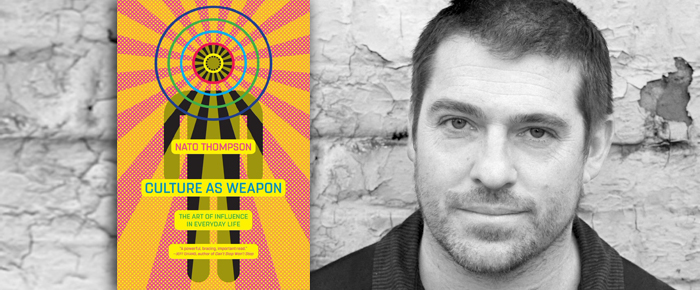
By Heidi Simmons
—–
Culture as Weapon
by Nato Thompson
Nonfiction
—–
Everyday, Americans participate in creating culture. Whether its getting coffee at Starbucks, Going Red for Women or simply retweeting a message, culture is shaping how American’s think and feel. Culture as Weapon: The Art of Influence in Everyday Life by Nato Thompson (Melville House, 288 pages) sets out to explain the role we play as those in power use culture to maintain and expand their influence on our lives, emotions and spending.
In the introduction, author Thompson notes the impact of global business, which in 2015, spent $600 billion to sway consumers. More than ever, advertising and public relations plays a critical role in daily business practices to alter culture.
Thompson defines art as something that has a potentiality for being both deeply coercive and absolutely powerful. Not only is he referring to the traditional arts like theater, film, dance and fine art, but also the art of advertising and PR.
Taking a look at recent history, Thompson includes how not only businesses, but politicians and world leaders manipulate cultural narrative to rally support and change public opinion.
The author shows how Hitler influenced an entire country with cultural propaganda that included art as bold symbolism, dynamic films and patriotic rhetoric.
In the United States, Ronald Reagan, Nixon, Clinton and Bush comprised narratives to change the conversation toward their political ends by utilizing public relations and advertising campaigns as well.
Trump too is included. Thompson, pointing to studies that show how anger and surprise are the most important emotions to get people activated, proves why Trump’s tweets – good or bad — are a success in getting people’s attention.
Thompson includes a brief history of the rise of PR and advertising and the great geniuses who switched-up the game.
Culture changing case studies in Culture as Weapon are detailed and fascinating. There’s David Petraeus’ “Community-Based Practice” of counterinsurgency tactics in the Middle East, the birth of Starbucks, the ingenious Swedish furniture company IKEA and the brilliance of the Apple Store.
There is a chapter on charitable gift giving. Thompson reports that in 2013, charities gave $335.17 billion just in the United States and that there are 1.41 million registered nonprofits contributing nearly $905.9 billion to the economy. He points to the power and manipulation that can change culture through philanthropy.
Thompson also shows how with the beginning of the Internet, the Zapatista movement in 1994 resisted the Mexican government — all while American intelligence studied their tactics.
As Thompson explores the rapidly changing nature of culture with social media, he shows just how precarious the “information age” is/was. He looks at the rapid rise and fall of MySpace and how the privatized space of the internet has monetized the basic functions of sociality.
I found the chapter on social artist Richard Florida regarding urban revitalization and his campaign to transform American cities through art compelling. Thompson points out how Florida’s plan to put the arts back into communities changes the culture of place. “Culture could be a tool, a piece of infrastructure, not unlike roads or streetlights or office parks or school districts,” says Thompson.
Gems of information about how people are manipulated and change culture abound in this book. Thompson delivers — “Simple fact: Fear motivates faster than hope, what appeals to emotions don’t rely on the truth, or rationality need not drive enthusiasm.”
Thompson’s Culture as Weapon is a timely and significant read about our changing culture as a society and as individuals. There is something that feels urgent about his message. He is sharing an important observation about who we are becoming as our digital world “augments the intimate needs of a person.”
In his conclusion Thompson warns, “With the advent of the internet and social media, this extension has melded the public and private into a powerful fulcrum that will rival the printing press in its effects on the entire ontology (or public opinion) of the people of this earth.”











































